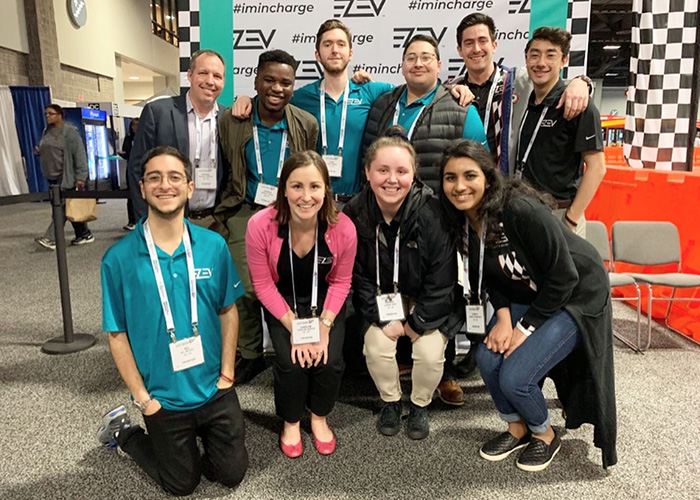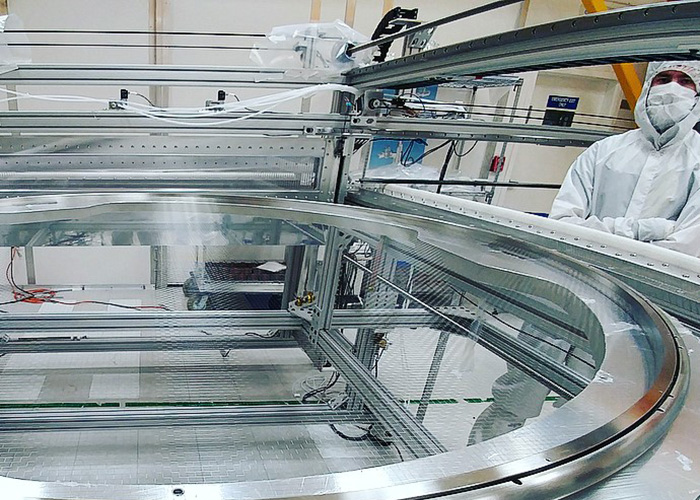Three Cool Co-Ops From Spring/Summer Cycle
By Kylie Gray
October 22, 2019
What do the Drexel family, MIT research and an electric vehicle startup have in common? They are all topics of recent co-ops completed by students in the College of Arts and Sciences! As the University celebrates 100 years of co-op, learn more about the amazing research and industry experiences of our majors, like history and sociology student Isabella Sangaline ’20, environmental studies and sustainability student Sumita Gangwani ’20, and physics student Philip Weigel ’20.
Tracking Down A.J. Drexel's Father
 Drexel student Isabella Sangaline examines a primary source document with Dornbirn archivists Werner Matt and Philipp Wittwer. Photo by Roxzine Scott.
Drexel student Isabella Sangaline examines a primary source document with Dornbirn archivists Werner Matt and Philipp Wittwer. Photo by Roxzine Scott.
When Isabella Sangaline recalls the location of her third co-op, she describes a city hemmed by the Alps, where the grass — even the color green — is brighter and more vibrant.
The city, Dornbirn, Austria, is also the former home of Francis Martin Drexel (FMD), father of University founder A.J. Drexel. Sangaline spent six months digging through the Dornbirn City Archive to unearth clues about the elder Drexel’s past.
A dual major in history and sociology, she had already dipped her toes into archival work during a five-day trip led by history Department Head Scott Knowles, PhD. Once they returned to Drexel, Knowles proposed something unexpected — a question that would lead to her co-op abroad: “What if we sent you to Austria?”
Sangaline immediately signed up for an introductory German course, and before long, she was immersed in the Dornbirn archives.
“It was important to learn about the history of not only Francis Martin Drexel, but also Dornbirn and Austria, because he didn’t exist in a vacuum — he had context,” she says.
She started with division of estate documents, which revealed information about the family’s structure and socioeconomic status. She also created a map that traced FMD’s movement through’s Switzerland, Italy and France over the course of six years, before he eventually settled in Philadelphia. One of her best archival finds was a letter from FMD to his children outlining his life in Europe.
“The archivists and I realized during this project that we don’t know as much about Francis Martin Drexel as we thought we did. Many of his accomplishments were overshadowed by those of his son and granddaughter,” she says, referring to granddaughter Saint Katharine Drexel, “but his life experiences are so unique and interesting.”
In fact, Sangaline argues that FMD was even more interesting than his famous son.
“Francis left Austria as an immigrant. He was in South America during revolutions. He was in California during the gold rush. There are so many different themes that apply to his life, like the role of social connections,” she says. “He had letters of recommendation from his father, but he didn’t follow his father’s path. Instead, he created his own networks.”
Now back on campus, Sangaline is hard at work converting her findings into a report that will serve as her senior thesis. She plans to submit her thesis to a peer-reviewed journal and is in talks with Dornbirn’s archive manager about translating it into German. She hopes that her co-op will be just the beginning of a much larger project continued by future Drexel students.
Launching the First Electric Vehicle Startup
By Sumita Gangwani, BS environmental studies & sustainability ’20
 Sumita Gangwani (bottom right) poses with other Exelon co-ops at the Washington Auto Show.
Sumita Gangwani (bottom right) poses with other Exelon co-ops at the Washington Auto Show.
Everyone has that dream job opportunity, the amazing boss you would love to work for, or the product you would never dream of promoting. In my last co-op at Drexel, I got the opportunity to experience all three as an innovation intern at Exelon.
Exelon is a Fortune 100 company responsible for the largest producer of renewable energy in the United States. Aside from its involvement in utilities and regulations is the ever-growing innovation sector dedicated to new energy opportunity areas. That area was where I found my co-op home as a member of the core startup team with Steer — the first-ever electric vehicle subscription service, based in Washington, D.C.
Starting as the “everything under the sun” co-op, my day to day included anything from editing the company’s FAQs to driving a few Teslas and designing our company hashtag (#steerwithus). My role eventually evolved into social media management and customer relations, a capacity in which I still work with the company today. My bosses are strong women, a CEO and COO duo who have inspired me to break boundaries and always innovate (and who have taught me that coffee is the best motivator!).
Working in a startup is everything like the movies, and also far from it. The teams are small and select, there are always snacks in the office, and there’s a new problem to deal with every day. The environment is fast paced, it is dynamic, it is quick thinking, and it is high intensity. Each person has a key part in executing the day-to-day strategy. The team is the brand from beginning to end, and most importantly, its success is contingent on the responsibility of everyone across the company.
My last co-op experience was all of this and more: It was family, it was innovative, it was exciting, and it continues to be an accumulation of passionate people. A startup is way more than a business idea with funding; it is the collective effort and passion of strong, disruptive-minded people. The lessons I have learned on this co-op go beyond the workplace. They are lessons of navigating the ups and downs, the hard days and small celebrations, in life.
Creating New Knowledge in Particle Physics
 Philip Weigel beside a detector that is part of the LZ dark matter experiment at SLAC National Accelerator Laboratory, operated by Stanford University. Photo courtesy of @lzdarkmatter.
Philip Weigel beside a detector that is part of the LZ dark matter experiment at SLAC National Accelerator Laboratory, operated by Stanford University. Photo courtesy of @lzdarkmatter.
Joining the search for dark matter and developing novel neutrino technologies would seem to be a highlight of any student’s college experience — just ask senior physics major Philip Weigel. Weigel has completed two particle physics research co-ops at MIT and one at Stanford, returning to MIT’s Laboratory for Nuclear Science this spring to pick up where his first co-op left off.
His trajectory into research can be traced back to Associate Physics Professor Michelle Dolinski, PhD, who advised Weigel, then an electrical engineering major, during his first-year STAR scholarship. He has worked in her lab almost every term since, helping with particle detector research and development as part of her work in experimental neutrino physics.
He says the liquid xenon technology they use in Dolinski’s lab to look for rare nuclear decays is similar to the technology he worked on at Stanford’s SLAC National Accelerator Laboratory, where he joined the search for dark matter.
“There is a lot of evidence for dark matter. The best explanation for these effects is that there is some invisible matter that doesn’t interact with light — and according to our current understanding in physics, dark matter should be a kind of particle,” he says. “These liquid xenon detectors are looking for very infrequent collisions between the atomic nuclei of xenon and dark matter particles. Scientists have been looking for it for decades, and we haven’t seen it yet.”
Weigel’s work at both Drexel and Stanford involved developing technology to perform the most sensitive searches for new phenomena. But at MIT, it was all about optimization — this time, on a particle accelerator for a new kind of particle search.
As a member of the IsoDAR collaboration, he worked on a particle accelerator called a cyclotron. The cyclotron accelerates ions from low to medium energies, creating a particle beam that generates neutrinos when it hits a target. The goal of the IsoDAR experiment is to search for a theoretical particle called a sterile neutrino.
Weigel’s project focused on the particles’ injection and the first few turns in the cyclotron. His goal was to increase the beam intensity — which is the number of particles the beam delivers per second — by a factor of five over the current world record. The problem, he says, is an effect called space charge, which causes divergence in the beam.
“In order to get the desired electrical beam current out, you have to make everything as efficient as possible,” he says. “Theoretical models of what accelerator structures should look like are very idealized. That kind of approximation works well for typical accelerators, but not for this kind of ‘pushing the limit’ application. We were trying to take these models and transform them into something that works for our high intensity beam, and accounts for real-life effects that are hard to calculate analytically.”
While at Stanford, Weigel was mostly building detector components — think plumbing and wire grids in a clean room — at MIT, his work on particle accelerators involved a lot of coding. He continues to consult with his MIT colleagues on the project that he led.
Whether the application is neutrinos, dark matter, or other kinds of particles, it’s the prospect of discovering new physics that keeps Wiegel interested in developing new instrumentation and experimental techniques. A Goldwater Scholarship recipient, he plans to continue his work in experimental particle physics by pursuing a PhD after graduation.